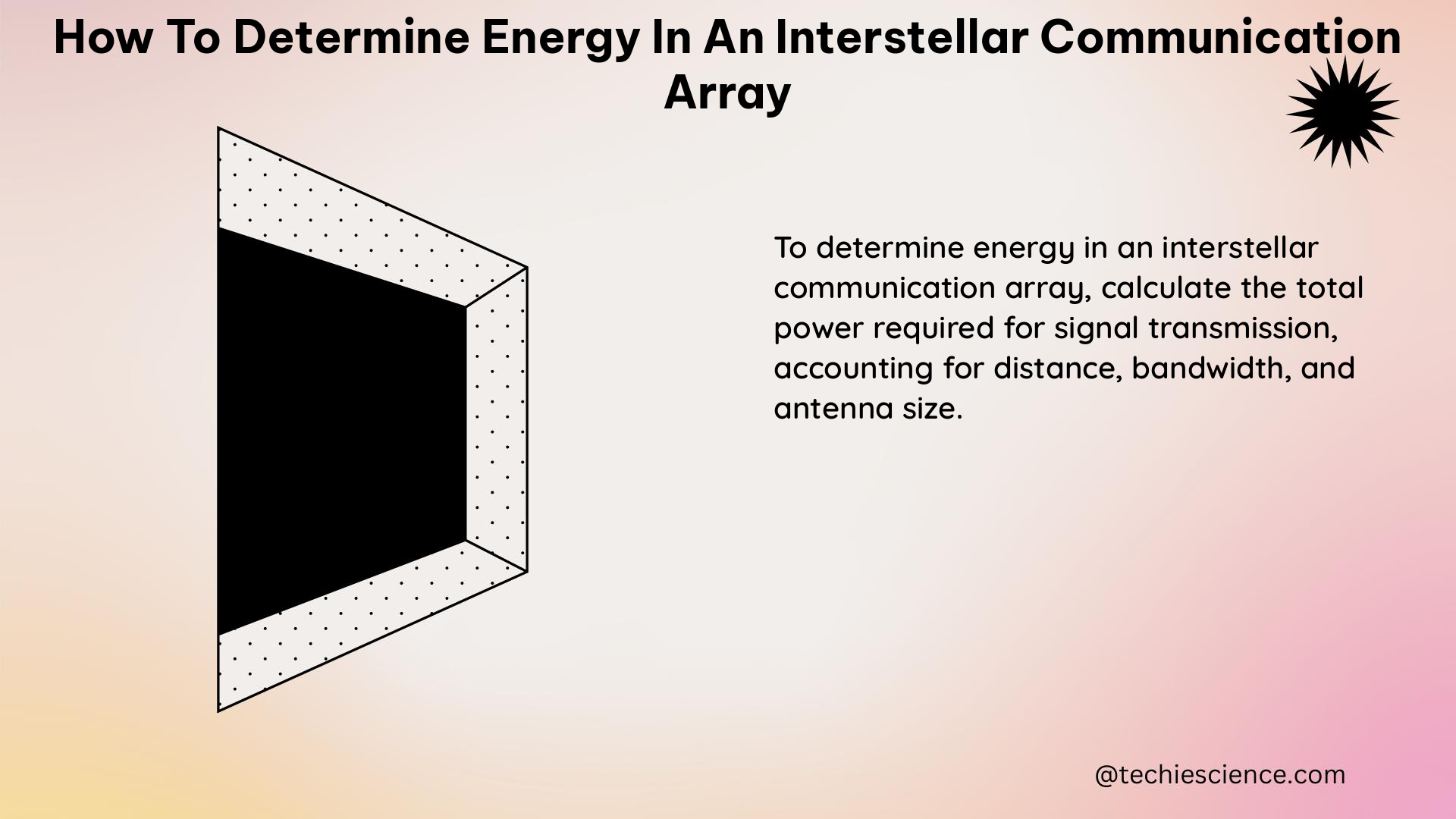Determining the energy requirements for an interstellar communication array is a critical aspect of designing an efficient and effective system for transmitting data across vast distances in space. This comprehensive guide will delve into the key factors, formulas, and numerical examples to help you understand the process of calculating the energy needed for such an array.
Free-Space Path Loss
The first step in determining the energy requirements is to calculate the free-space path loss, which is the loss in signal power due to the distance between the transmitter and receiver. The formula for free-space path loss is:
L = (4πd/λ)^2
Where:
– L is the free-space path loss (in watts per square meter)
– d is the distance between the transmitter and receiver (in meters)
– λ is the wavelength of the signal (in meters)
This formula takes into account the inverse square law, which states that the intensity of a signal decreases with the square of the distance from the source.
Example Calculation
Let’s consider a scenario where the distance between the transmitter and receiver is 1 light-year (9.46 × 10^12 km) and the wavelength of the signal is 21 cm (the wavelength of the 21 cm hydrogen line).
L = (4π(9.46 × 10^12 m)/(0.21 m))^2
L = 1.58 × 10^20 W/m^2
This means that the free-space path loss for a signal traveling 1 light-year with a wavelength of 21 cm is 1.58 × 10^20 W/m^2.
Received Power

Once we have calculated the free-space path loss, we can determine the received power, which is the transmitted power divided by the free-space path loss. The formula for received power is:
Pr = Pt / L
Where:
– Pr is the received power (in watts)
– Pt is the transmitted power (in watts)
– L is the free-space path loss (in watts per square meter)
Example Calculation
Suppose the transmitted power is 1 megawatt (10^6 W) and the distance and wavelength are the same as the previous example.
Pr = 10^6 W / (1.58 × 10^20 W/m^2)
Pr = 6.31 × 10^-15 W
This means that the received power for a 1 megawatt signal traveling 1 light-year with a wavelength of 21 cm is 6.31 × 10^-15 watts.
Optimal Frequency
To maximize the data rate in an interstellar communication system, it is important to operate at the optimal frequency, which is the frequency that maximizes the signal-to-noise ratio (SNR). The optimal frequency depends on the distance between the transmitter and receiver, as well as the background noise level.
The background noise level in an interstellar communication system is dominated by the cosmic microwave background (CMB), which has a temperature of approximately 2.7 K. The minimum energy required to transmit a bit of information is determined by the CMB temperature and the bandwidth of the signal.
Minimum Energy per Bit
The minimum energy required to transmit a bit of information can be calculated using the following formula:
Emin = kTB log2(1/p)
Where:
– Emin is the minimum energy required to transmit a bit of information (in joules)
– k is the Boltzmann constant (1.38 × 10^-23 J/K)
– T is the CMB temperature (2.7 K)
– B is the bandwidth of the signal (in hertz)
– p is the probability of error
Example Calculation
Let’s consider a scenario where the frequency of the signal is 1 GHz (1 × 10^9 Hz) and the bandwidth is 1 Hz, with a probability of error of 10^-6.
Emin = (1.38 × 10^-23 J/K)(2.7 K)(1 Hz) log2(1/10^-6)
Emin = 1.27 × 10^-20 J
This means that the minimum energy required to transmit a bit of information at a frequency of 1 GHz with a bandwidth of 1 Hz and a probability of error of 10^-6 is 1.27 × 10^-20 joules.
Interstellar Coherence Hole
The interstellar coherence hole captures the time and frequency coherence constraints, and observations of the environment by the transmitter and receiver can constrain the burst parameters and limit the search scope. This concept is crucial in optimizing the energy efficiency of the interstellar communication array.
Additional Considerations
- Encoding schemes, such as location codes (e.g., Morse code), can be used to minimize the energy required to transmit a bit of information.
- The interstellar environment, including the presence of dust, gas, and other obstacles, can affect the signal propagation and energy requirements.
- Antenna design, beam-forming techniques, and other advanced technologies can be employed to optimize the energy efficiency of the communication array.
Conclusion
Determining the energy requirements for an interstellar communication array is a complex task that involves considering various factors, including free-space path loss, received power, optimal frequency, and minimum energy per bit. By understanding the underlying principles and applying the relevant formulas and numerical examples, you can design an efficient and effective interstellar communication system that minimizes the energy consumption while maximizing the data rate and reliability.
References
- Interstellar Water Chemistry: From Laboratory to Observations
- 2021 Census of Interstellar, Circumstellar, Extragalactic Molecules
- Breakthrough Propulsion Study – NASA Technical Reports Server
- Interstellar communication. III. Optimal frequency to maximize data rate
- Design for minimum energy in starship and interstellar communication

The lambdageeks.com Core SME Team is a group of experienced subject matter experts from diverse scientific and technical fields including Physics, Chemistry, Technology,Electronics & Electrical Engineering, Automotive, Mechanical Engineering. Our team collaborates to create high-quality, well-researched articles on a wide range of science and technology topics for the lambdageeks.com website.
All Our Senior SME are having more than 7 Years of experience in the respective fields . They are either Working Industry Professionals or assocaited With different Universities. Refer Our Authors Page to get to know About our Core SMEs.